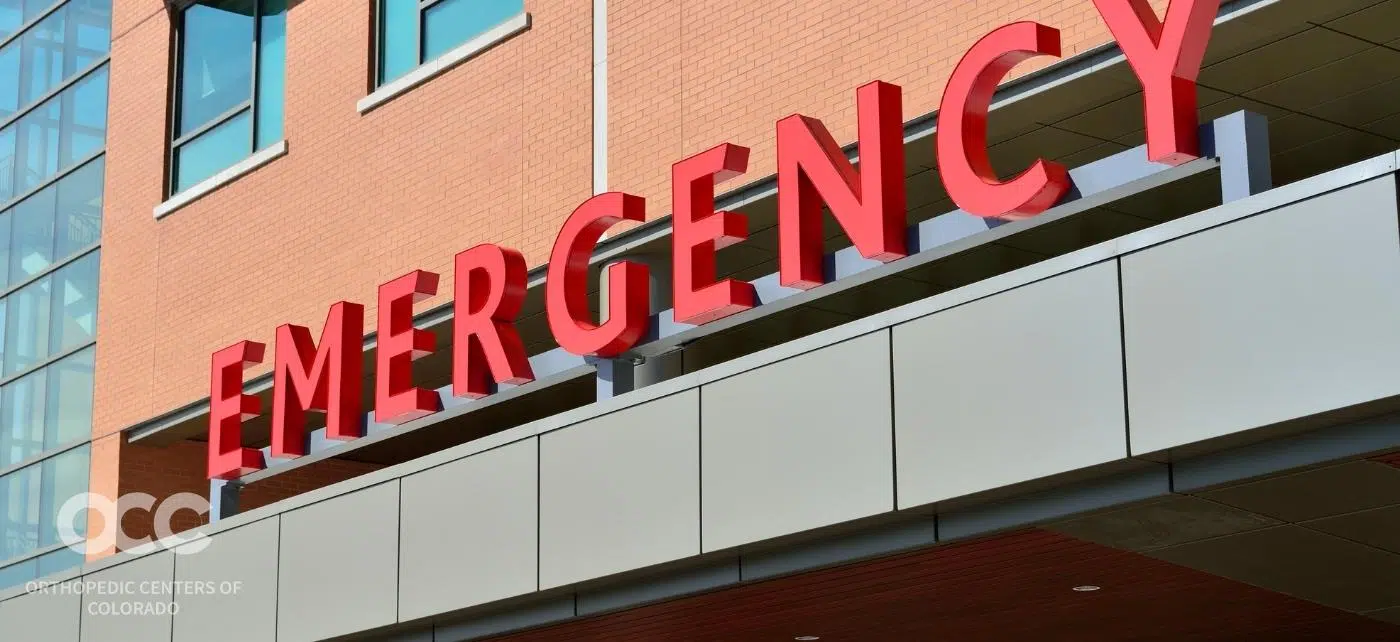When you need orthopedic care, choosing where to go and when is an important first step in finding relief. It is important to remember that if you are facing a life-or-limb-threatening emergency, calling 911 and going to the emergency room is the right thing to do. How do you decide whether to visit a physician’s office, urgent care, or an emergency room? To ensure you get the right care at the right time but do not overpay for care, it is important to know your options and the costs associated with them. Making an informed choice can save you time, money, and frustration.
Here are some tips to help you make the most informed care decision for various situations.
When should I go to a hospital emergency room (ER)?
Hospital emergency rooms are for urgent or life-threatening medical needs. ERs are equipped with facilities and trained professionals to treat life-threatening situations such as injuries to the head, neck, spine, as well as impaired breathing, excessive blood loss, loss of limb use/feeling, and other issues that require immediate attention. If someone’s condition is critical, an emergency call to 911 and/or a trip to the ER should be the first course of action.
In life-threatening situations, financial costs are never the first focus, but it is important to know that emergency rooms are generally the most expensive care option available. The average hospital emergency room visit costs nearly $1,500 and can be much more expensive depending on your situation.
When dealing with an emergency, it is extremely unlikely the focus will be on costs, and it may be impossible to identify if each service provider (i.e., physicians, anesthesiologists) is in your insurance network or if each procedure or test is covered by your health plan.
Hidden fees, such as hospital facility fees, are also common. Facility fees and/or provider-based billing fees can represent charges for the location/facility where services were performed. Individual health care plans will determine co-pays, out-of-network charges, deductibles, and overall patient responsibility, and the process can take several weeks. Understanding which hospitals are in your insurance network before you are in an emergency situation is good to know, but in a true emergency, getting to the nearest ER quickly should be first priority.
What about these new emergency rooms that are not part of a hospital? Are they “real” ERs?
In areas of Denver, you have probably noticed a number of new facilities popping up that say “Emergency Room” on the sign, but they are not co-located with a hospital. Even though they are not physically attached to a hospital, they are typically affiliated with one and have similar pricing and services.
You may see them in the same areas you find urgent care facilities, which has caused a great deal of confusion about what types of care these facilities provide.
These freestanding facilities can provide essential care in rural areas or in areas that don’t have nearby hospitals. In urban areas, however, it is easy for someone to mistake a freestanding ER for an urgent care location, getting stuck with an ER-sized bill when they thought they were going to urgent care. As always, it pays to be informed and ask how the facility bills its services.
When should I go to urgent care?
If your orthopedic need is not life-threatening, you still have choices to make. Your orthopedic surgeon or primary care provider are great options. Other possibilities include walk-in clinics and urgent care facilities. Time is a key factor in considering these options.
If your medical need is time sensitive or occurs outside of traditional office hours an urgent care may be a good option. Urgent care centers offer expanded hours and can provide a timely evaluation and diagnosis to set patients on the right path to recovery.
It is common for urgent care providers to conduct a physical examination, check vital signs, and conduct diagnostic tests in order to provide immediate treatment, provide pain management, and recommend any necessary follow-up. This can include a follow-up appointment with an orthopedic specialist who will review the initial diagnosis, offer additional expertise, determine if additional imaging is needed, support your recovery process, and make additional treatment recommendations, including surgery.
Examples of orthopedic conditions treated in an urgent care include simple fractures, tendon or muscle tears, and joint dislocations. Urgent care facilities treat urgent needs, and much of the medical treatment is performed by a nurse or physician’s assistant who has access to a trained physician.
As with emergency rooms, the costs for urgent care are typically higher, and some locations may not be in your health plan network. Urgent care copays are often two times higher (or more) than a visit to a physician.
Should I go to a physician’s office?
For all non-emergency situations getting an appointment with a physician is your most cost-effective resource for medical care and referrals. If your insurance requires a primary care physician (PCP), see if they can fit you in quickly or consider scheduling a telehealth appointment to refer you to an orthopedic specialist more quickly.
If your insurance plan does not require a visit to a PCP then the most efficient route to optimal care is to make an appointment with an orthopedic specialist. Some offices offer same-day or next-day care for pressing needs which saves time and money and allows patients to begin recovery.
The urgency of your condition, access to care, and individual medical plan parameters are the factors that guide where to receive medical care. Once you make that choice, it is equally important to ensure that your billing matches the services received and the benefits from your provider. Be aware and diligent in spotting overcharging, double-billing, and rogue fees, which can be unfortunate components of many large facilities’ billing patterns.
According to Medical Billing Advocates of America, a national association that reviews medical bills for consumers, 80% of hospital bills contain errors. Many states have taken steps to help consumers become more informed. This includes legislation intended to limit financial surprises for patient care and requirements that increase billing transparency. A diligent approach remains important for the consumer.
Being informed about your options for care, the best resources for types of care, and the costs associated with them will help you make informed choices about what is right for you. Learn more about our orthopedic specialists or request an appointment on our website.













